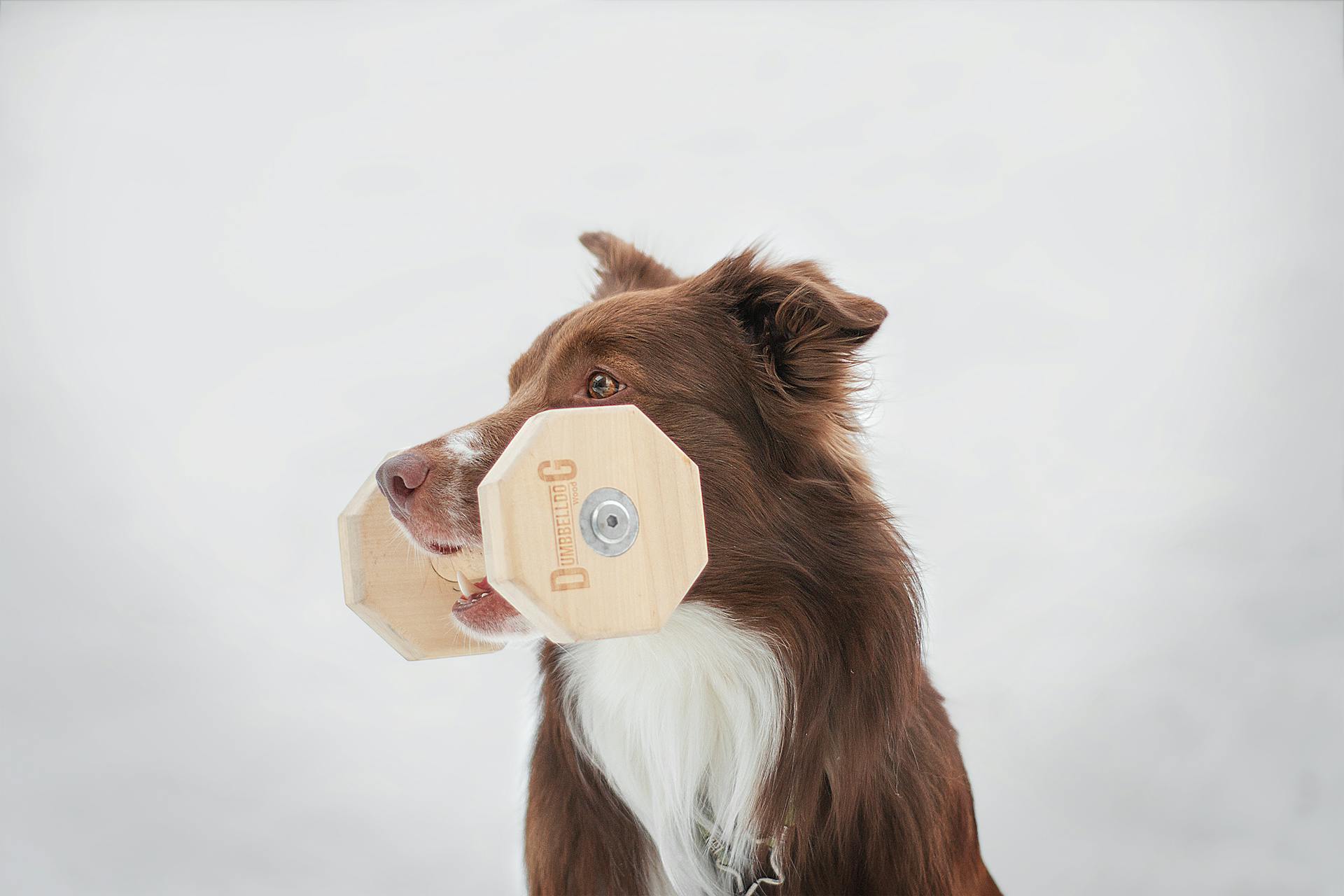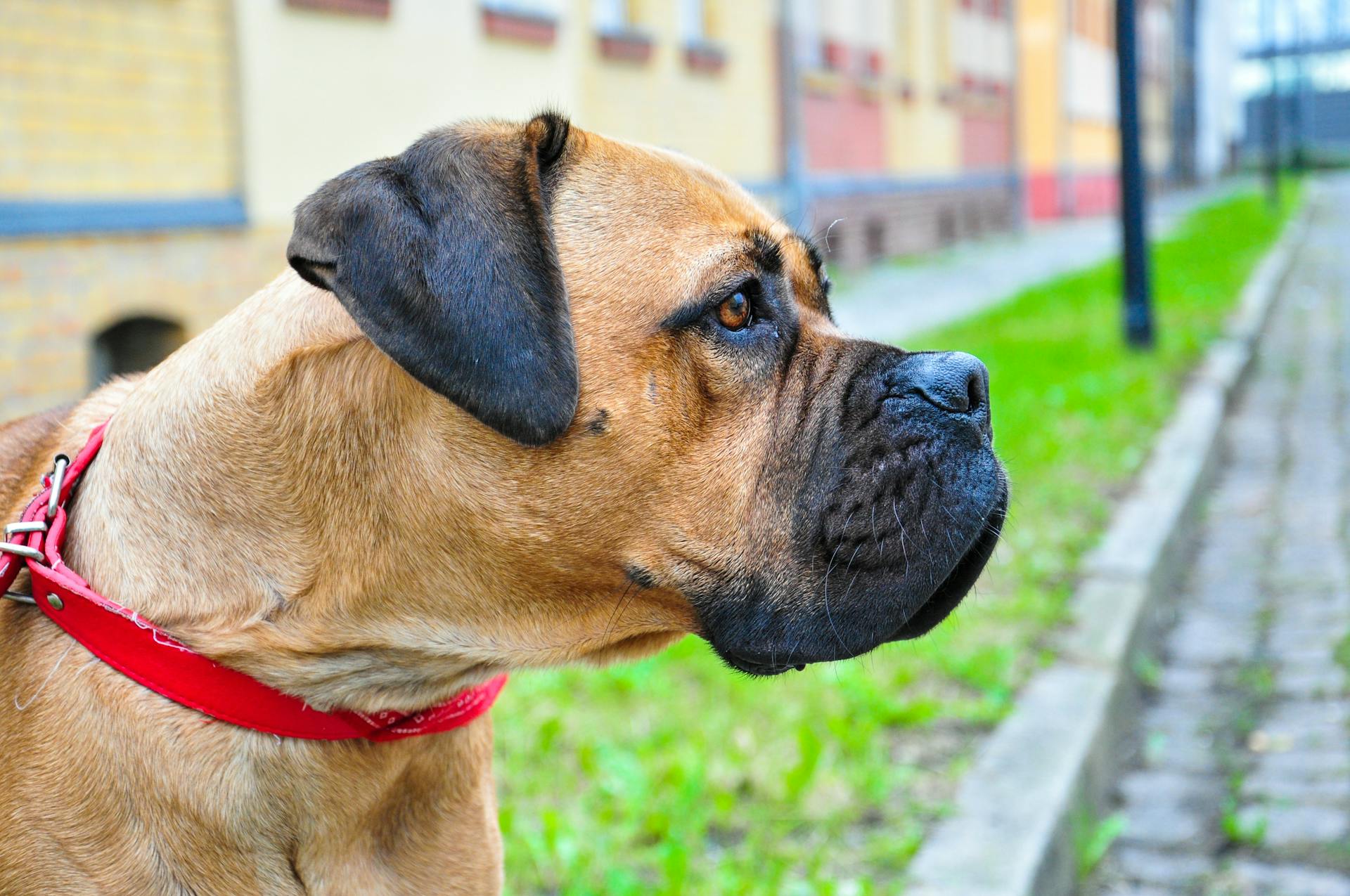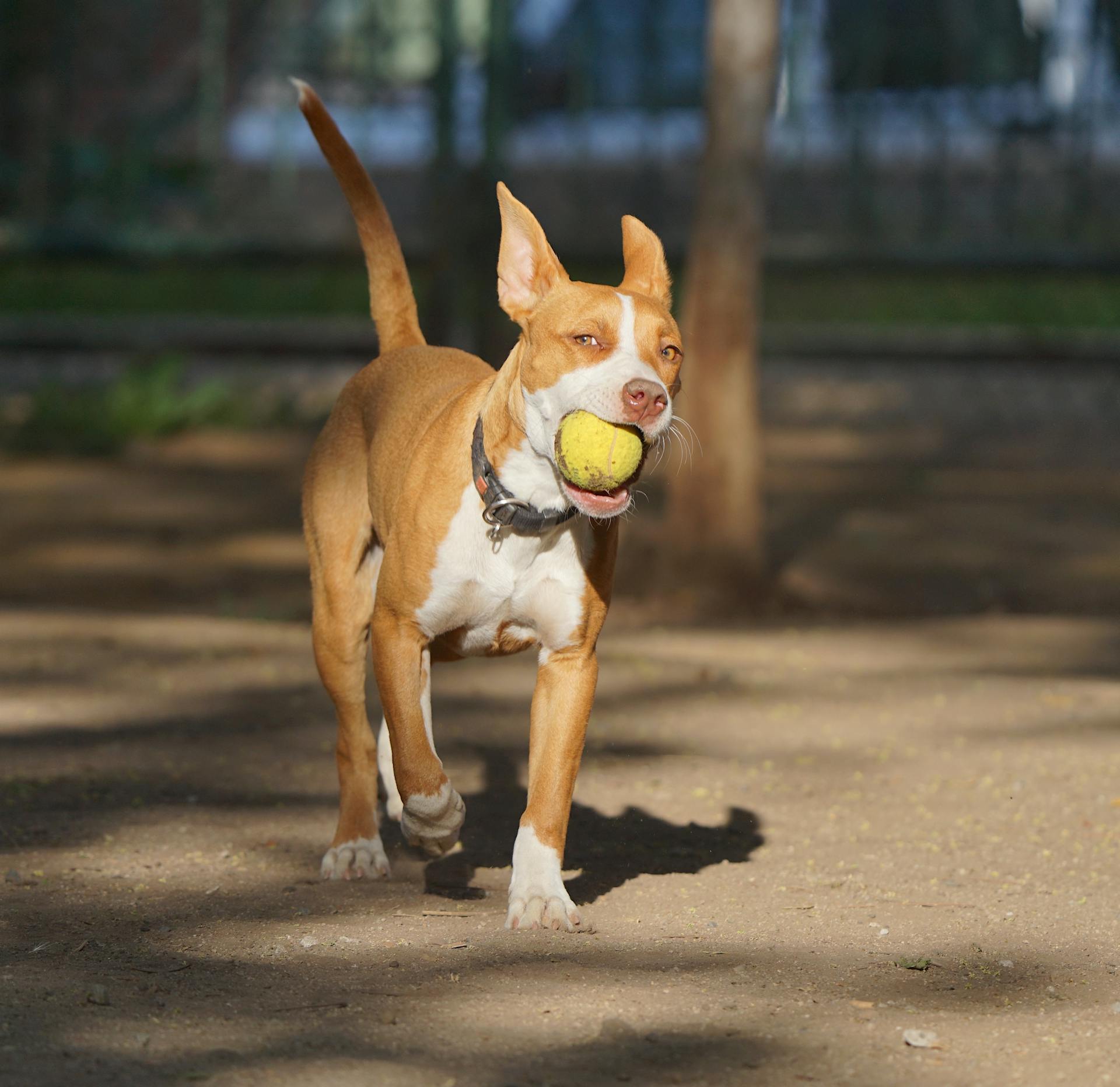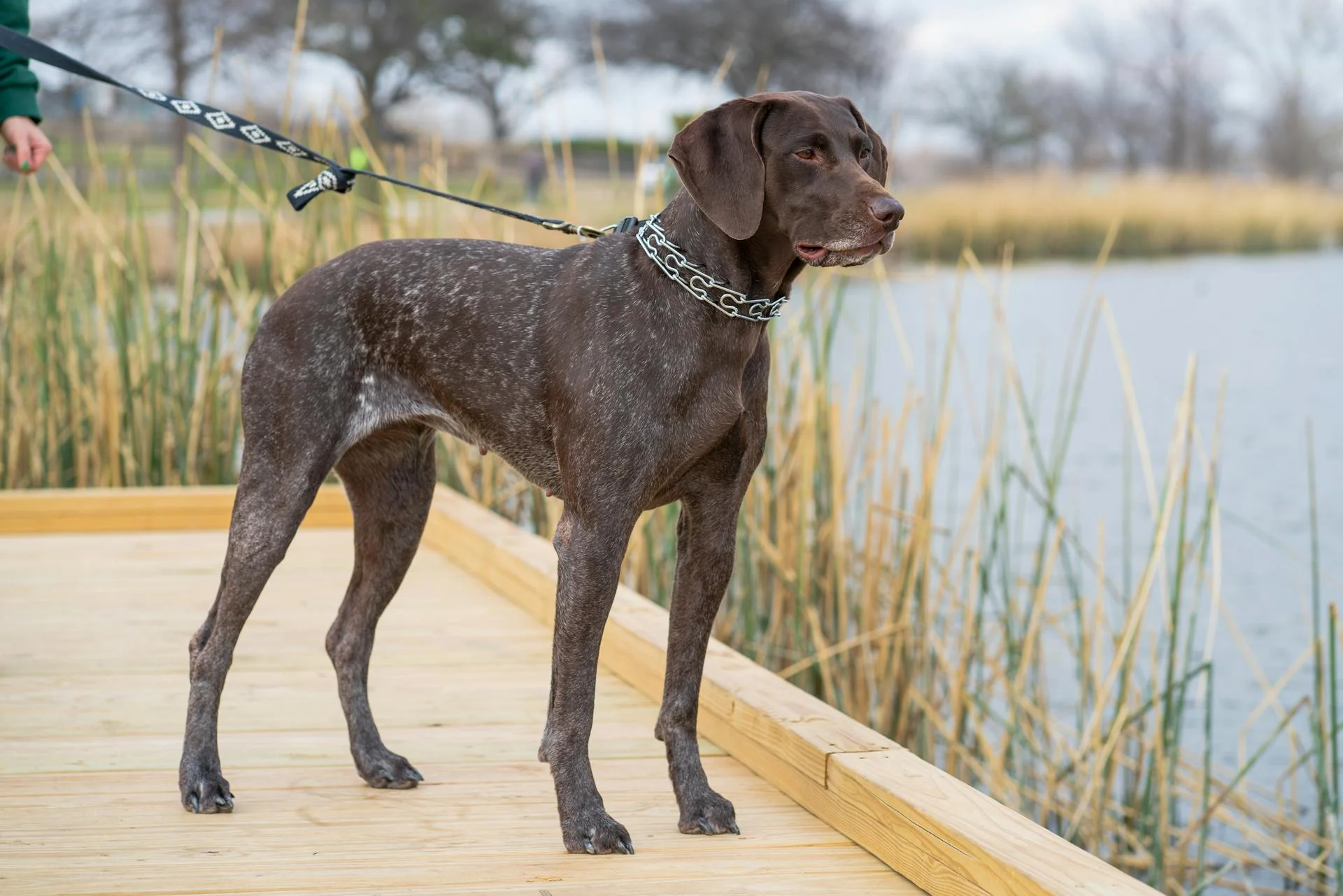
Force free gundog training is a game-changer for dog owners and trainers alike. It's based on the understanding that dogs learn best through positive reinforcement, not punishment or fear.
Dogs are highly motivated by rewards, such as treats and praise, which can be used to encourage desired behavior. In fact, a study found that dogs are more likely to repeat a behavior if it's followed by a reward than if it's followed by a correction.
The key to successful force free gundog training is to focus on what the dog is doing right, rather than what they're doing wrong. By doing so, you can build trust and strengthen your relationship with your dog.
Dog Training Fundamentals
Dog training fundamentals are the building blocks of a strong relationship between you and your gundog. Consistent verbal commands, well-timed whistle blasts, and hand signals are key to effective communication with your dog.
A prolonged single whistle and raised hand can give the same instruction as "sit" or "hup", where the dog sits and stays beside the handler or partway to the object being retrieved.
For recall, multiple quick whistle "pips" are a signal for your dog to come to you. This can be a lifesaver in the field, especially when your dog is off-lead.
To teach your dog to heel, you'll need to practice walking beside your handler. This can be a challenging task, but with patience and consistency, your dog will learn to walk by your side.
A place command is useful when you need your dog to return to a specific location, such as a board or elevated plank. This can be especially helpful in situations where your dog needs to wait or calm down.
The release command, such as "okay" or "done", lets your dog know it's time to return to hunting or another activity after completing a task.
Here are the basic commands you'll need to teach your gundog:
- Sit or Hup: The dog sits and stays beside the handler or partway to the object being retrieved.
- Come or Here: The dog comes to the handler.
- Heel: The dog walks beside the handler.
- Place: The dog returns to a board or elevated plank, sits, and waits.
- Release: The dog's name, "okay", "done", "go", or another release word lets the dog return to hunting or another activity after completing a task.
- Fetch: The dog retrieves a ball, bird, or other object and returns it to the handler.
- Deliver to hand: The dog drops the picked-up item into the handler's hand.
Remember, the key to successful dog training is consistency, patience, and positive reinforcement.
Positive Reinforcement Techniques
Clicker training is a powerful tool for teaching dogs new skills, and it's not just for gundogs. With clicker training, you can mark events and reward good behavior, making it a great way to build a strong bond with your dog.
Robert Milner, a renowned trainer, has seen the benefits of clicker training firsthand. He used clicker training to rebuild the search-dog program for Tennessee Task Force One after 9/11, and the results were impressive.
By using positive reinforcement techniques, you can reduce the learning curve for novice trainers and help dogs learn quickly and retain their skills over time. In fact, Milner's positive-training model reduced the initial projected 18 months for compulsion training to just six months.
Positive reinforcement training focuses on well-timed rewards for incremental improvements in exercises designed around the dog's interests and abilities. This approach eliminates the need for punishments like scolding, hitting, or electric shocks.
With clicker training, you can teach your dog to perform complex tasks, like search and retrieval, in a fun and engaging way. And, as Robert Milner's results show, this approach is not only effective but also efficient.
By incorporating positive reinforcement techniques into your training, you can create a more enjoyable and rewarding experience for both you and your dog.
Training Tools and Methods
Clicker training is a powerful tool for teaching gundogs new skills, and it can even work at a distance. Once the dog is out of earshot, clicker training relies on the dog's understanding of the association between the click and the reward.
You can use clicker training to teach a number of skills to your gundog, including basic obedience and hunting skills. It's a great way to build a strong bond with your dog and to make training a fun and rewarding experience.
Clicker training may not work with every dog, but it's worth trying with your own gundog. The key is to present tasks in small pieces, one at a time, and to reward your dog for each success.
Breaking tasks into small pieces is an essential part of force-free training. This approach helps to prevent frustration and confusion, and it allows your dog to learn at its own pace.
There are many resources available to help you with force-free gundog training. You can find books, online resources, and videos that offer step-by-step guidance through every phase of training, from basic obedience to advanced hunting skills.
Some great resources for force-free gundog training include the book "Force-Free Gundog Training: The Fundamentals for Success" by Jo Laurens, and the website "forcefreegundog.com" run by Jo Laurens.
Debunking Common Myths
Most modern dog trainers use food in training. This is a far cry from the myths that surround the use of food in gundog training circles.
Many people believe that using food in training is a sign of laziness or poor training skills, but the truth is that most trainers use food to make training more efficient and effective. In fact, most modern dog trainers use food in training.
Using food in training doesn't mean you're relying on treats to control your dog's behavior, but rather it's a tool to help them learn and understand what's expected of them.
Using Place Boards
Using place boards can be a game-changer for dog training, as trainers like Horak have found. Place boards act as a safe "home base" that helps dogs develop patience and steadiness while learning voice, whistle, and hand signals.
A place board can be anything from a piece of plywood to an elevated deck with a non-skid surface. Horak began adapting place board training and developed drills that gave him and his dogs a rapport and control they'd never experienced before.
Trainers who use place boards swear by their effectiveness, and many of Horak's customers use them for family dogs or dogs involved in agility, basic obedience, tricks, police work, or the military. In 2018, Horak and two of his Cocker Spaniels won American Kennel Club Spaniel Field Trial National titles, for which he credits positive-reinforcement training and board practice.
By using place boards, trainers can create a safe and rewarding environment for their dogs to learn and grow. Horak's success with place boards is a testament to the power of positive-reinforcement training.
6 Food Myths Debunked
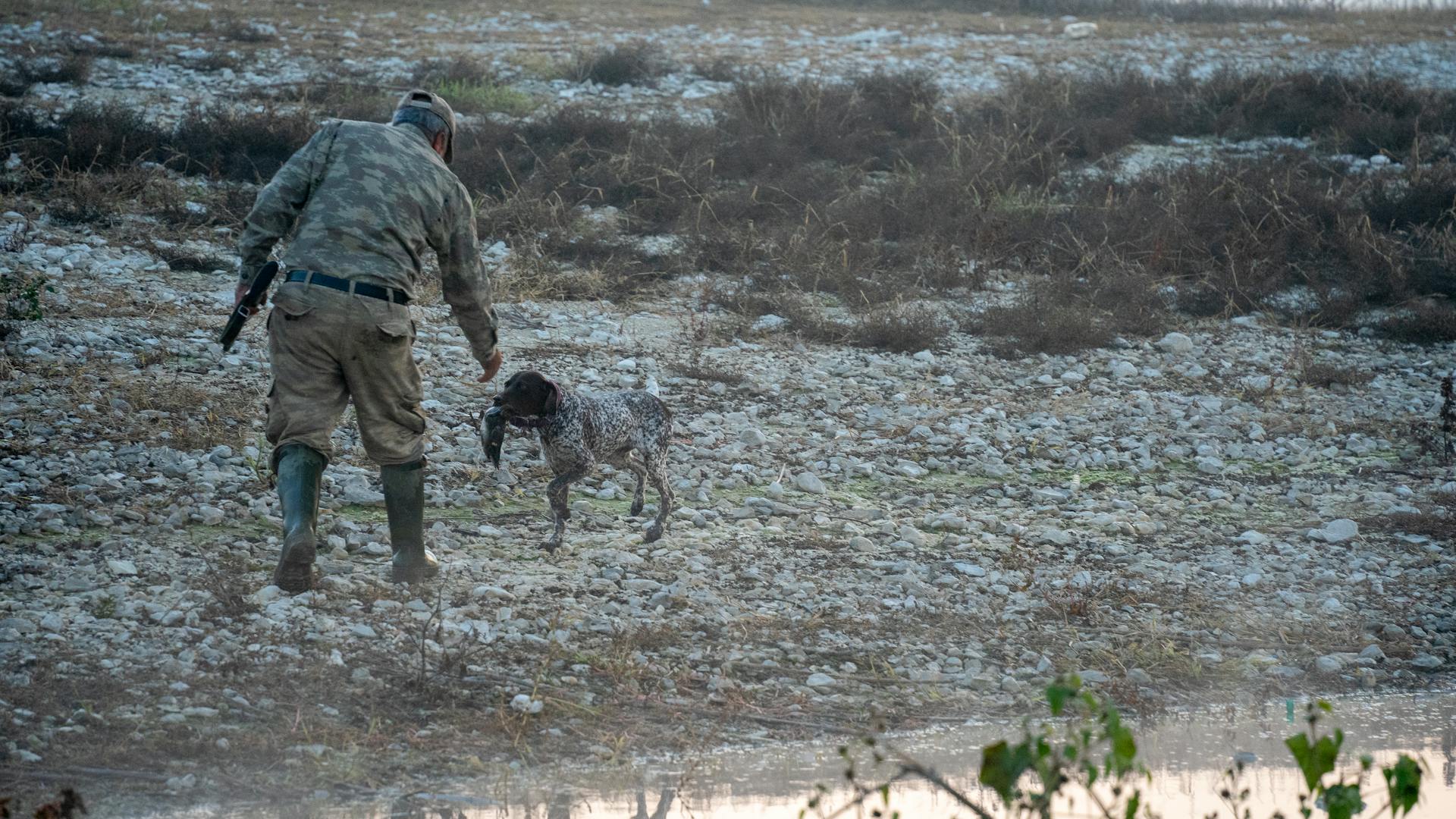
Most modern dog trainers use food in training. This is a stark contrast to the common perception that food is not used in gundog training.
Food rewards are a staple in many training methods, yet some trainers still believe they're not effective for gundogs. This myth has persisted despite the fact that many successful trainers rely on food rewards.
The idea that food rewards will spoil gundogs and make them less responsive to commands is a common concern. However, this is not supported by evidence, and many trainers have found that food rewards can actually improve a dog's focus and responsiveness.
Using food rewards in gundog training doesn't mean you're bribing your dog; it's a way to associate desired behaviors with a positive outcome. In fact, most modern dog trainers use food rewards as a way to motivate and engage their dogs in training.
Additional reading: Names for Gundogs
Benefits of Clicker Training
Clicker training is about marking events, which helps your dog learn quickly and efficiently. This method can be used with any dog, regardless of age or breed.
Clicker training can be used to teach a number of skills to your gundog, including basic obedience and hunting skills. I know I was skeptical about clicker training when I first tried it, but now I use it regularly.
The method is effective because it allows your dog to associate the sound of the clicker with a reward, making them eager to learn. This makes training sessions enjoyable for both you and your dog.
Clicker training can be used to teach a number of skills to your gundog, including basic obedience and hunting skills.
Fetch and Gundog Training
Fetch is a fundamental skill for gundogs. It's a crucial part of their training, and it's essential to teach it using force-free methods.
A prolonged single whistle and raised hand can give the same instruction as "sit" or "hup", but for "fetch" the dog retrieves a ball, bird, or other object and returns it to the handler. This is a key part of gundog training.
To teach your gundog to fetch, you'll want to start with a ball or other object that's easy for them to pick up and carry. You can use a clicker to mark the exact moment they pick up the object, and then reward them with a treat.
Here are the basic steps for teaching your gundog to fetch:
Remember, consistency is key when teaching your gundog to fetch. Use the same whistle and hand signal every time, and make sure to reward them with treats and praise when they get it right.
Sources
- https://www.dogwise.com/force-free-gundog-training-the-fundamentals-for-success/
- https://online.dogsmarttrainingbehaviour.co.uk/p/beginners-gundog
- https://www.whole-dog-journal.com/training/lessons-from-force-free-gundog-trainers/
- https://totallygundogs.com/category/gundog-training/methods/force-free/
- https://school.grishastewart.com/courses/clicker-retrieve
Featured Images: pexels.com
